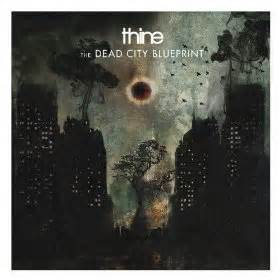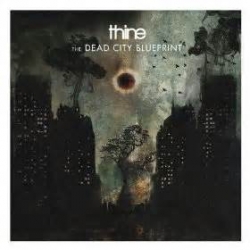Formed in the UK in 1995, bleak prog quintet Thine is certainly not opposed to taking a while to release material. Like prog metal favorites Cynic and Tool, they have a surprisingly limited discography for a group with such a lengthy history. However, like those other two acts, Thine isn’t wasting any time; rather, the group works tirelessly to ensure that each new release is meticulously detailed and very rewarding. Fortunately, their newest opus, The Dead City Blueprint, was well worth the wait. Atmospheric, catchy, and powerful, the record is a delight from beginning to end, although it’s a little less diverse than it could be. Hell, even the title is cryptically alluring.
The Dead City Blueprint follows 1997’s A Town Like This and 2002’s In Therapy, and they’ve done their best to ensure that this one “[builds] upon the sublime hooks & dark existential themes” of its predecessors. Although the decade spent creating the work was “a long & grueling process,” it was worth it for the end result, which is nothing less than “an encapsulation of all those glorious tragedies… [it’s] a welcome catalyst. Sometimes the best art comes only through being unexpectedly forced through the city’s darkest avenues…” Most artists would agree that it often takes hardships to produce meaningful pieces, and that’s certainly what this LP is full of.
The full-length brings in the melancholic spirit immediately with “Brave Young Assassin,” a biting and bittersweet rock rebellion. Its opening piano chords are eerily reminiscent of ghostly heartache found within Steven Wilson’s The Raven that Refused to Sing, while the pained guitar chords and vocals evoke Anathema’s Alternative 4. Its gripping because of its relentless passion and tight musicianship; one imagines that the group is exhausted emotionally each time they perform it. “Flame to the Oak” and “Out of Your Mind and Into a Void” are a bit more nuanced and rustic, with tinges of Agalloch in the background, but they follow the same path more or less.
As an acoustic ballad, the title track is considerably more moody and reserved, with low harmonies making the desperation sound more urgent. Stimulatingly, “The Rift” somewhat combines both styles into a nice package, and it even concludes with soaring and emotive guitar layers on top. “Scars from Limbo” brings piano back for thoughtful accompaniment, while the final track, “Adrift through the Arcane Isles of Recovery” sounds as macabre as you’d expect. It’s essentially just a soundscape consisting of forlorn strings, piano, and rainfall. Near the end, an organ motif takes center stage, and it’s very arresting as another fine example of how the most dramatic music can be made by combining instrumentation and natural sounds.
All in all, The Dead City Blueprint is intense, tragic, and raucous, just like rock music should be. Truthfully, it could be a bit more varied and brave, as it becomes too comfortable with its own set aesthetic, so don’t be surprised if you find yourself unable to differentiate tracks for the first few listens. Still, they manage to subvert this issue by piling on the sentimental outbursts and dynamic shifts needed to keep it consistently interesting. Let’s just hope that a follow-up comes before this decade is out.
*All quotations come from the album’s official press release.


